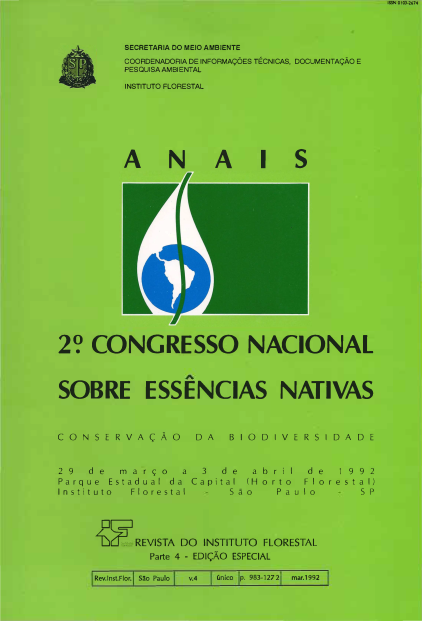TECNOLOGIAS FUTURAS
APLICAÇÃO DA POLlEMBRIOGÊNESE PARA A PROPAGAÇÃO MASSAL DE PLANTAS ELITE DE ARAUCARIAANGUSTIFOLIA (BERT.) O. KUNTZE
DOI:
https://doi.org/10.24278/2178-5031.199244784Keywords:
Plant tissue culture, somatic polyembryogenesis, Araucaría angustífolía, mass clonal propagation, synthetic seedsAbstract
Reconstitution in plant morphogenesis is a type of vegetative propagation in which the reorganization of embryonic tissue does occur. When embryonal-suspensor cells (young zygotic embryo) are excised and inoculated in suitable culture medium new embryonal-suspensor cells are originated by cleavage and budding processes. This phenomenon has been described in gymnosperms and its manipulation may allow the mass donal propagation of elite plants, as well the improvement and the germ plasm conservation. Young needles and mature embryos of Araucaría angustífolía (Bert.) O. Kuntze were inoculated in LP (VON ARNOLD & ERIKSSON, 1981) and MS (MURASHIGE & SKOOG, 1962) media supplemented with 2,4-0, BAP and KIN, and showed the proliferation of callus tissue that couldn't be subcultured and showed no embryogenic characteristics. Immature zygotic embryos containing embryonal-suspensor masses (ESM) were. inoculated in the same media and the proliferation of new ESM with embryonic features were demonstrated. Condition for obtaining repetitive cycles of cell division and the scale-up of this ESM were established. Experiments are in progress with the aim of establishing embryogenic cell lines in liquid suspension and obtaining somatic embryos and/or synthetic seeds.
Downloads
References
CARPANEZZI, A A; PEREIRA, J. C. D.; CARVALHO, P. E. R.; REIS, A; RODRIGUES, A R. F.; ROTTA, E.; STURION, J. A; RAUEN, M. J.; SILVEIRA, R. A ,1988. Zoneamento ecológico para plantios florestais no Estado de Santa Catarina. EMBRAPNCNPF. Curitiba.
CHEAH, K-T. & CHENG, T- Y., 1978. Histological analysis of adventitius bud formation in cultures Douglas Fir cotyledon. Amer. J. Bot., 65(8):845-49.
DURZAN, D. J. & CHALUPA, V., 1976. Growth and metabolismo of cells and tissue of jack pine (Pinus banksiana). 3. Growth of cells in liquid suspension cultures in light and darkness. CanoJ. Bot., 54:456-467.
DURZAN, D. & GUPTA, P. K., 1987. Somatic embryogenesis and polyembryogenesis in Douglas-fir cell suspension cultures. Plant Science, 52:229-235.
DURZAN, D. J., 1988a. Process control in somatic polyembryogenesis.ln: Hallgreen, J.E. (ed.). Molecular GeneticsofForest Trees. pp. 147-186.Swedish Univ. of Agric. Sci. Sweden.
DURZAN, D. J., 1988b. Somatic polyembryogenesis for the multiplication of tree crops. Biotechnology and Genetic Engineering Reviews, 6:339-76.
DURZAN, D. J. 1990. Adult vs. juvenile explants: direct totipotency. PlantAging: Basic and applied approaches. pp. 19-25. New York.
DURZAN, D. J. & DURZAN, P. E ., 1991. Future technologies; model reference control systems for the scale-up of embryogenesis and polyembryogenesis in cell suspension cultures. In: Micropropagation.
DEBERGH, P. C. & Zimmerman, R. H. (eds.). pp.389-423. Kluwer Academic Publ, Netherlands.
GIFFORD, E. & FOSTER, A. S., 1988. Morph%gy and Evolution of Vascular Plants. Freman and Company. New York. 626 p.
GUPTA, P. K. & DURZAN, D. J. 1987. Somatic embryos from protoplasts of loblolly pine proembryonal cells. Bio/Technology, 5:710-712.
HAKMAN, I. & VON ARNOLD, S., 1985. Plantlet regeneration through somatic embryogenesis in Picea ·lO abies (Norway Spruce). J. Plant Physiol., 1 21 :149-158.
HAKMAN, I; FOWKE, L. C.; VON ARNOLD, S.; ERIKSSON, T., 1985. The development of somatic embryos in tissue cultures initiated from immature embryos of Picea abies (Norway Spruce). Plant Sci., 38:53-59.
HONG, L. ; BOULAY, M. ; GUPTA, P. K., DURZAN, D. J., 1991. Variations in somatic po/yembryogenesis: induction of adventitious embryonal-suspensor masses on deve/oping doug/as-fir embryos. Data not published.
MAENE, L. & DEBERGH, P., 1987.Araucaria. In: Cell and Tissue Culturein Forestry. Bonga, J. M. & DURZAN, D. J. (eds.). pp. 176-84. Martinus Nijhoff Pub. Dordrecht. V.3.
MO, L. H.; VON ARNOLD, S.; LAGERCRANTZ, V., 1989. Morphogenic and genetic stability in longtern embryogenic cultures and somatic embryos of norway spruce (Picea abies (L.) Karst). Plant Cell Rep., 8:375-378.
MURASHIGE, T. & SKOOG, F., 1962. A revised médium for rapid growth and bioassay with tobacco tissue cultures. Physiol. PI., 15:473-497.
REITZ, R.; KLEIN, R. M.; REIS, A., 1978. Projeto Madeira de Santa Catarina. Separata nº 28 de Sellowia-Herbário Barbosa Rodrigues. Itajaí. 320 p.
SINNOTT, E. W., 1960. Plant Morphogenesis. McGraw Hill, New York.
TAUTORIUS, T. E.; FOWLE, L. C.; DUNSTAN, D.I., 1991. Somatic embryogenesis in conifers. Cano J. Bot. 69:1873-1899.
VON ARNOLD, S. & ERIKSSON, T., 1981.ln vitro studies of adventitious shoot formation in Pinus contorta. Can. J. Bot., 59:870-74.
















